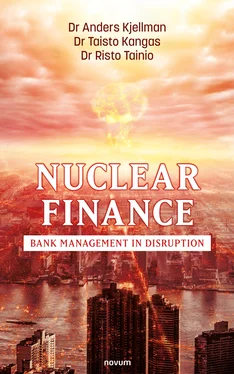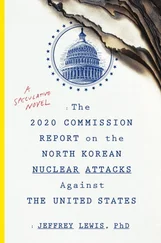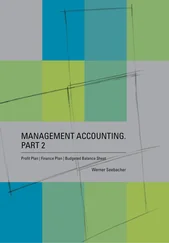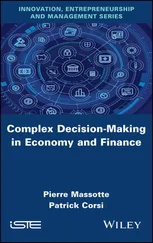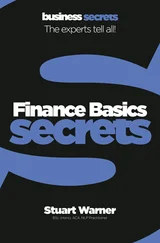Figure 1 shows the present global financial system and hopefully gives a sense of the interdependence of all the various actors. In the centre we find the Central Banks in the USA, Europe, China, India, Japan, Canada etc. working together with the International Monetary Fund (IMF) for short-term stability, and the World Bank, (WB, IBRD) and other Multinational Development Banks (MDB) to maintain a “long-term stable financial environment” in the world. This is not an easy task and a malfunction in any of the financial centres can easily spread a feeling of fear at lightning speed, which, in the worst-case scenario, may even cause a meltdown of the entire global financial system. The worst-case scenario is not the most likely scenario, however. Instead, a slow process of tension build up is a more likely outcome. This tension can then be defused at a slow or fast rate, a situation in which somebody usually loses, while others may gain. In late 2020, researchers at CERN found that the atoms do not only consist of neutrons, protons and electrons. A forth element dubbed “odderon” was proven to exist. “Odderon” or a glue that keeps nuclear cores as well as business cores together is what we are going to have a closer look at.
The purpose is to describe patterns of good and bad banking practice
Bank management and success in banking is a complex issue. It is about more than just understanding economics or some part of finance. When we studied the activities of successful and unsuccessful bankers, we noticed that truly value creating managing directors seem to master not only customer relations but also personnel relations and financial instruments. However, they are also able to grasp institutional history and its effect on the future of the financial institution. In other words, the good managers seem to be good at seeing the big picture of their banks and their role in the society of the future. This is also our starting point from theoretical perspectives that drives a good bank manager. After years of analysing successful bank managers, we have adopted a theoretical basis for this book. You will need to know about your past, your environment, your culture, your customers and your expected future before you, as a banker, will stand a chance of being successful in the long-term.
We try to provide a comprehensive and experienced-based introduction to issues relating to the work of bank managers. In Chapters 2 and 3 we will provide important and fascinating insights into the business of banking. A major reason for writing this book has been to fill a gap in the literature on bank management and bank performance, in practice. Another purpose of this book is to provide an institutional perspective on banking, so that we can learn from history, in order to increase the prospects for right moves in the uncertain future of banking. A third motive behind this book is to cast some light on the complexity of banking. We will provide descriptions and conceptualizations rather than explanations involved in the processes of managing banks and money.
What lies behind bad banking? In Chapter 4 we will analyse the steps behind banks that entered the history books as failures! A new and fascinating issue in the downfall of banks relates to the growth phase – often associated with a stigma of fear – which then develops into the crisis stages of banks in decline. We looked at three hundred and nine bank mergers and found that bank managers in many cases gradually lost their confidence concerning their capability to run their banks successfully, and then opted for a bank merger. The reasons behind mergers seem to be time and context dependent. In our model of bank decline, we see the role of the bank managers as crucial. The major reasons behind the recent wave of bank mergers seems to be bad bank management and real economic crises, caused by the global financial crisis that started in 2008, with the downfall of Lehman Brothers; and we can expect more bank mergers to occur after the 2020–2 coronavirus crisis.
Initially, we started out to investigate bank crises. We were puzzled by a lot of things. One surprising finding was that in banking, we (Kjellman, Tainio & Kangas, 2014) noted that decline cannot be understood without first looking at growth before the decline phase. In the early 2020’s, one can see a worrying amount of asset growth in the holdings of the Central Banks – and that is a source of problems in the future.
In previous times of crisis, bank managers in most cases gradually lost their confidence concerning their ability to successfully run their banks, and consequently opting for a bank merger. The mergers occurred after a bank growth phase among the banks. Some bankers became blinded and then led their banks into a crisis phase. Faced with two perceived options, i.e., to merge or to declare “bankruptcy”, the bankers naturally chose to merge. We argue that this perceived no-other-way-out-than-to-merge argument may be used to explain most bank mergers and failures. The “satisfactory” solution for the latent financial problems was seen by many managing directors to be to merge. We have seen how mergers were created by managers and authorities. They didn’t just happen! Instead, mergers were created in order to hide profitability problems, that could not be dealt with in an acceptable way.
The required shake-up of a bank did not call for a declaration of mistakes made by bank managers. The layoffs were blamed on the merger, and many of the bankers could continue as a bank manager or retire with a golden handshake. The board members were given an excuse for not previously seeing the emerging problems, often due to an omnipotent, ‘culture-of-fare’ Managing Director. The board of the bank opted for a merger and were then handed the argument that thereby they were doing something about the profitability problem. The personnel, who were not laid-off, were promised a future in the new banking organisation and thereby some of their lost trust could be regained. The customers were promised a larger and leaner bank that would offer an increased and improved service capability. In fact, the choice to enter into a merger seemed to be appealing, at least partly, to all of the involved stakeholders. And consequently, the problem of bad banking could be put aside!
Financial Institutions die at a surprisingly young age! Why? Is it due to economic fluctuation, a banking crisis, bank runs, bad management or halo effects? Is it a fact that so-called ‘great-man’ stories simply don’t work in banking? In our quest to figure out what might lie behind great banks, we initially had to define what good bank management is. We decided to define “good bank management as long-term, constant value creating banking activity that maintains good profitability both during good and bad times, while maintaining loyal customers, loyal owners and loyal employees (including managers)”. Our definition of good bank management supports the issue of long-term survival as well as the loyalty effect suggested by Reichheld (1996).
In Chapter 5 we will analyse good bank management! What are the factors influencing good bank management? The first big lesson of our study on good bank management and leadership is that you should apply a holistic view to banking. Look to the past and see where you are coming from. Look at your own and the bank’s current life space, i.e., the current situation. Make sure that you have sufficient funds of your own, good liquidity, a solid bank platform strategy, loyal owners and a staff that is motivated, well educated, and loyal. Look first to the past and then to the future and assess in which direction you, the customers, technological improvements, and the markets are going. Great bankers are often experienced and manage to motivate their co-workers. Therefore, they create a secure workplace, a stable rock, which enables the co-workers, customers, and the surrounding society to grow. It is hard to lead by example if you are not experienced, so having older employees is a good thing in prudent banking.
Читать дальше
